#aggressive roller skating
Text
alley oop soul <3
#roller skating#street skating#street style#aggressive skating#aggressive roller skating#patins#skate or die#diy skate#roller skates#roller skate#skatelife#skate and create#bettyspaghettylegs#spaghettylegs
8 notes
·
View notes
Text
Only a year or so late. SKATE EDIT 2023
#Selfie#Video#Skate edit#Short#I need to video so much more often#Skating#Rollerblading#Rollerskating#One ok rock#Rock edit#Shirtless#Aggressive inline#inline skating#Inlines#roller skating#Skate#Skatepark#540#grindcore#Grind#2000s#Y2k#Emo#Dcom brink#I've gotten so much better but it's been months since I've skated#2000s aesthetic#90s#90s aesthetic
50 notes
·
View notes
Text
“he roller skates!” “they’re air shoes.” is designed to kill me specifically because firstly that’s so fucking funny and the presentation and the line delivery is fucking amazing and also secondly shadow’s shoes are originally based on inline skates NOT roller skates (well technically inlines are a kind of roller skate but in a broader context “roller skates” are almost exclusively used to refer to quad skates. inlines have their wheels in a line, quads are quadragled) and his animation is 100% based on quad skating in prime BUT SHADOW IS AN INLINE SKATER ORIGINALLY HIS SHOES ARE BASED ON INLINE SKATES SA2 WOULD NOT EXIST WITHOUT INLINE SKATING I CARE IMMENSELY ABOUT THIS
#NOT EVEN JOKING ABOUT THE LAST BIT#THE GRINDING MECHANIC OF SA2 AND SOAP SHOES ARE BASED ON INLINE SKATES#PLUS THE CULTURAL CONTEXT OF THE TIME OF ITS DEVELOPMENT WOULDVE JUST BEEN CATCHING THE TAIL END OF THE ERA OF AGGRESSIVE INLINE SKATES#skateboarding but inline skating as well are crucial components to what sonic’s very personality and the tone/aesthetic of sonic adventure#also inline skating way way faster than quad skating#genuinely genuinely i’m not mad i’m not mad i’m not mad#prime is great this bit is great the animation of prime and shadow in prime is great shadow is great#i’m not even angry!! it’s such a good bit!!! it’s animated well! roller skates are more well known today!!!#BUT HAVE THEY CONSIDERED THAT I CARE IMMENSELY ABOUT SHADOW THE HEDGEHOG AND INLINE SKATES AND SHADOW ON INLINE SKATES?!? NO!!!#his animation in sa2 and heroes and shth is based on inline skating also#his animation in 06 is quad based but it also sucks complete ass so it doesn’t exist to me#most other skating animations of his are mid and i haven’t analyzed them enough to tell#theres a large grace area i give cause i don’t expect animations to be 100% accurate to real movements#plus the air shoes while based on inlines are their own thing and i think it’s nice when they embrace that#BUT FUCK QUAD SKATES#i don’t hate quad skates inlines are just cooler by an order of magnitude to me and them being the default makes me sad :(#rambles#prime#action sport posting#<- yeah. thats a tag. it will be used more in the future
131 notes
·
View notes
Text
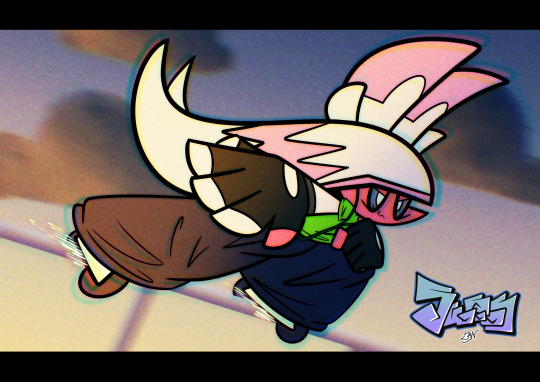
#art#artists on tumblr#fanart#fan art#pokemon#pokémon#pokemon fanart#pokrmon oc#pokesona#tinkaton#bam the tinkaton#y2k#y2k art#early 2000s#roller skates#aggressive inline#baggy jeans#big pants
33 notes
·
View notes
Photo


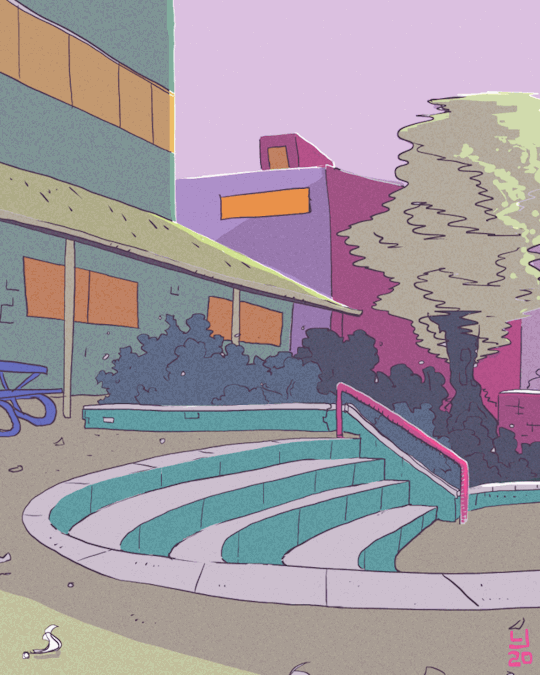
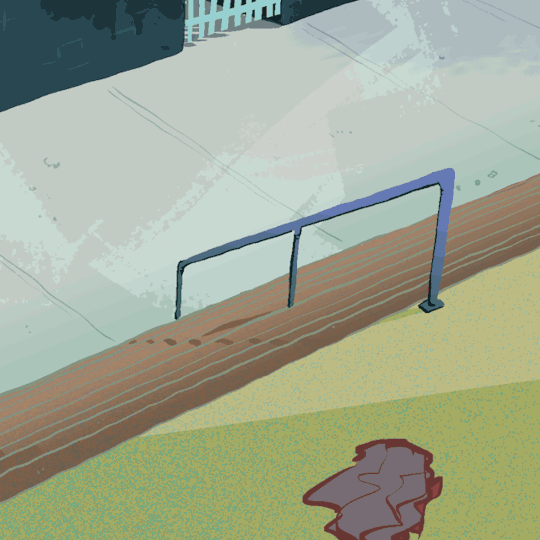

Really love Rollerblading hey!
www.louiejoyce.com
#Louie Joyce#Illustration#Animation#Rollerblading#Loop#Gif#Animate#Roller Skating#Inline Skating#Inline Skates#aggressive skating#Grind#Skate#Skate Animation#Skating#Skate or die#Blade or die#Street Skating#Comics#Comic Animation#Cartoon#Sequential Art
143 notes
·
View notes
Video
youtube
Why is this sport not more popular?
#aggressive inline#aka#rollerblading#inline vert#skating#skaters#half pipe#I don't know how to tag this properly#but I was the reigning roller rink limbo champ at the age of nine and I did it on blades#so there's that#this is so cool and smooth
8 notes
·
View notes
Video
youtube
Jacob Juul Fall 2023 | Trigger Skate
#youtube#triggerskate#rollerblading#inline skating#aggressive skating#skate#roller#extreme sports#triggerextremesports
0 notes
Text
Gig apps trap reverse centaurs in Skinner boxes

Enshittification is the process by which digital platforms devour themselves: first they dangle goodies in front of end users. Once users are locked in, the goodies are taken away and dangled before business customers who supply goods to the users. Once those business customers are stuck on the platform, the goodies are clawed away and showered on the platform’s shareholders:
https://pluralistic.net/2023/01/21/potemkin-ai/#hey-guys
If you’d like an essay-formatted version of this post to read or share, here’s a link to it on pluralistic.net, my surveillance-free, ad-free, tracker-free blog:
https://pluralistic.net/2023/04/12/algorithmic-wage-discrimination/#fishers-of-men
Enshittification isn’t just another way of saying “fraud” or “price gouging” or “wage theft.” Enshittification is intrinsically digital, because moving all those goodies around requires the flexibility that only comes with a digital businesses. Jeff Bezos, grocer, can’t rapidly change the price of eggs at Whole Foods without an army of kids with pricing guns on roller-skates. Jeff Bezos, grocer, can change the price of eggs on Amazon Fresh just by twiddling a knob on the service’s back-end.
Twiddling is the key to enshittification: rapidly adjusting prices, conditions and offers. As with any shell game, the quickness of the hand deceives the eye. Tech monopolists aren’t smarter than the Gilded Age sociopaths who monopolized rail or coal — they use the same tricks as those monsters of history, but they do them faster and with computers:
https://doctorow.medium.com/twiddler-1b5c9690cce6
If Rockefeller wanted to crush a freight company, he couldn’t just click a mouse and lay down a pipeline that ran on the same route, and then click another mouse to make it go away when he was done. When Bezos wants to bankrupt Diapers.com — a company that refused to sell itself to Amazon — he just moved a slider so that diapers on Amazon were being sold below cost. Amazon lost $100m over three months, diapers.com went bankrupt, and every investor learned that competing with Amazon was a losing bet:
https://slate.com/technology/2013/10/amazon-book-how-jeff-bezos-went-thermonuclear-on-diapers-com.html
That’s the power of twiddling — but twiddling cuts both ways. The same flexibility that digital businesses enjoy is hypothetically available to workers and users. The airlines pioneered twiddling ticket prices, and that naturally gave rise to countertwiddling, in the form of comparison shopping sites that scraped the airlines’ sites to predict when tickets would be cheapest:
https://pluralistic.net/2023/02/27/knob-jockeys/#bros-be-twiddlin
The airlines — like all abusive businesses — refused to tolerate this. They were allowed to touch their knobs as much as they wanted — indeed, they couldn’t stop touching those knobs — but when we tried to twiddle back, that was “felony contempt of business model,” and the airlines sued:
https://www.cnbc.com/2014/12/30/airline-sues-man-for-founding-a-cheap-flights-website.html
And sued:
https://www.nytimes.com/2018/01/06/business/southwest-airlines-lawsuit-prices.html
Platforms don’t just hate it when end-users twiddle back — if anything they are even more aggressive when their business-users dare to twiddle. Take Para, an app that Doordash drivers used to get a peek at the wages offered for jobs before they accepted them — something that Doordash hid from its workers. Doordash ruthlessly attacked Para, saying that by letting drivers know how much they’d earn before they did the work, Para was violating the law:
https://www.eff.org/deeplinks/2021/08/tech-rights-are-workers-rights-doordash-edition
Which law? Well, take your pick. The modern meaning of “IP” is “any law that lets me use the law to control my competitors, competition or customers.” Platforms use a mix of anticircumvention law, patent, copyright, contract, cybersecurity and other legal systems to weave together a thicket of rules that allow them to shut down rivals for their Felony Contempt of Business Model:
https://locusmag.com/2020/09/cory-doctorow-ip/
Enshittification relies on unlimited twiddling (by platforms), and a general prohibition on countertwiddling (by platform users). Enshittification is a form of fishing, in which bait is dangled before different groups of users and then nimbly withdrawn when they lunge for it. Twiddling puts the suppleness into the enshittifier’s fishing-rod, and a ban on countertwiddling weighs down platform users so they’re always a bit too slow to catch the bait.
Nowhere do we see twiddling’s impact more than in the “gig economy,” where workers are misclassified as independent contractors and put to work for an app that scripts their every move to the finest degree. When an app is your boss, you work for an employer who docks your pay for violating rules that you aren’t allowed to know — and where your attempts to learn those rules are constantly frustrated by the endless back-end twiddling that changes the rules faster than you can learn them.
As with every question of technology, the issue isn’t twiddling per se — it’s who does the twiddling and who gets twiddled. A worker armed with digital tools can play gig work employers off each other and force them to bid up the price of their labor; they can form co-ops with other workers that auto-refuse jobs that don’t pay enough, and use digital tools to organize to shift power from bosses to workers:
https://pluralistic.net/2022/12/02/not-what-it-does/#who-it-does-it-to
Take “reverse centaurs.” In AI research, a “centaur” is a human assisted by a machine that does more than either could do on their own. For example, a chess master and a chess program can play a better game together than either could play separately. A reverse centaur is a machine assisted by a human, where the machine is in charge and the human is a meat-puppet.
Think of Amazon warehouse workers wearing haptic location-aware wristbands that buzz at them continuously dictating where their hands must be; or Amazon drivers whose eye-movements are continuously tracked in order to penalize drivers who look in the “wrong” direction:
https://pluralistic.net/2021/02/17/reverse-centaur/#reverse-centaur
The difference between a centaur and a reverse centaur is the difference between a machine that makes your life better and a machine that makes your life worse so that your boss gets richer. Reverse centaurism is the 21st Century’s answer to Taylorism, the pseudoscience that saw white-coated “experts” subject workers to humiliating choreography down to the smallest movement of your fingertip:
https://pluralistic.net/2022/08/21/great-taylors-ghost/#solidarity-or-bust
While reverse centaurism was born in warehouses and other company-owned facilities, gig work let it make the leap into workers’ homes and cars. The 21st century has seen a return to the cottage industry — a form of production that once saw workers labor far from their bosses and thus beyond their control — but shriven of the autonomy and dignity that working from home once afforded:
https://doctorow.medium.com/gig-work-is-the-opposite-of-steampunk-463e2730ef0d
The rise and rise of bossware — which allows for remote surveillance of workers in their homes and cars — has turned “work from home” into “live at work.” Reverse centaurs can now be chickenized — a term from labor economics that describes how poultry farmers, who sell their birds to one of three vast poultry processors who have divided up the country like the Pope dividing up the “New World,” are uniquely exploited:
https://onezero.medium.com/revenge-of-the-chickenized-reverse-centaurs-b2e8d5cda826
A chickenized reverse centaur has it rough: they must pay for the machines they use to make money for their bosses, they must obey the orders of the app that controls their work, and they are denied any of the protections that a traditional worker might enjoy, even as they are prohibited from deploying digital self-help measures that let them twiddle back to bargain for a better wage.
All of this sets the stage for a phenomenon called algorithmic wage discrimination, in which two workers doing the same job under the same conditions will see radically different payouts for that work. These payouts are continuously tweaked in the background by an algorithm that tries to predict the minimum sum a worker will accept to remain available without payment, to ensure sufficient workers to pick up jobs as they arise.
This phenomenon — and proposed policy and labor solutions to it — is expertly analyzed in “On Algorithmic Wage Discrimination,” a superb paper by UC Law San Franciscos Veena Dubal:
https://papers.ssrn.com/sol3/papers.cfm?abstract_id=4331080
Dubal uses empirical data and enthnographic accounts from Uber drivers and other gig workers to explain how endless, self-directed twiddling allows gig companies pay workers less and pay themselves more. As @[email protected] explains in his LA Times article on Dubal’s research, the goal of the payment algorithm is to guess how often a given driver needs to receive fair compensation in order to keep them driving when the payments are unfair:
https://www.latimes.com/business/technology/story/2023-04-11/algorithmic-wage-discrimination
The algorithm combines nonconsensual dossiers compiled on individual drivers with population-scale data to seek an equilibrium between keeping drivers waiting, unpaid, for a job; and how much a driver needs to be paid for an individual job, in order to keep that driver from clocking out and doing something else.
@
Here’s how that works. Sergio Avedian, a writer for The Rideshare Guy, ran an experiment with two brothers who both drove for Uber; one drove a Tesla and drove intermittently, the other brother rented a hybrid sedan and drove frequently. Sitting side-by-side with the brothers, Avedian showed how the brother with the Tesla was offered more for every trip:
https://www.youtube.com/watch?v=UADTiL3S67I
Uber wants to lure intermittent drivers into becoming frequent drivers. Uber doesn’t pay for an oversupply of drivers, because it only pays drivers when they have a passenger in the car. Having drivers on call — but idle — is a way for Uber to shift the cost of maintaining a capacity cushion to its workers.
What’s more, what Uber charges customers is not based on how much it pays its workers. As Uber’s head of product explained: Uber uses “machine-learning techniques to estimate how much groups of customers are willing to shell out for a ride. Uber calculates riders’ propensity for paying a higher price for a particular route at a certain time of day. For instance, someone traveling from a wealthy neighborhood to another tony spot might be asked to pay more than another person heading to a poorer part of town, even if demand, traffic and distance are the same.”
https://qz.com/990131/uber-is-practicing-price-discrimination-economists-say-that-might-not-be-a-bad-thing/
Uber has historically described its business a pure supply-and-demand matching system, where a rush of demand for rides triggers surge pricing, which lures out drivers, which takes care of the demand. That’s not how it works today, and it’s unclear if it ever worked that way. Today, a driver who consults the rider version of the Uber app before accepting a job — to compare how much the rider is paying to how much they stand to earn — is booted off the app and denied further journeys.
Surging, instead, has become just another way to twiddle drivers. One of Dubal’s subjects, Derrick, describes how Uber uses fake surges to lure drivers to airports: “You go to the airport, once the lot get kind of full, then the surge go away.” Other drivers describe how they use groupchats to call out fake surges: “I’m in the Marina. It’s dead. Fake surge.”
That’s pure twiddling. Twiddling turns gamification into gamblification, where your labor buys you a spin on a roulette wheel in a rigged casino. As a driver called Melissa, who had doubled down on her availability to earn a $100 bonus awarded for clocking a certain number of rides, told Dubal, “When you get close to the bonus, the rides start trickling in more slowly…. And it makes sense. It’s really the type of
shit that they can do when it’s okay to have a surplus labor force that is just sitting there that they don’t have to pay for.”
Wherever you find reverse-centaurs, you get this kind of gamblification, where the rules are twiddled continuously to make sure that the house always wins. As a contract driver Amazon reverse centaur told Lauren Gurley for Motherboard, “Amazon uses these cameras allegedly to make sure they have a safer driving workforce, but they’re actually using them not to pay delivery companies”:
https://www.vice.com/en/article/88npjv/amazons-ai-cameras-are-punishing-drivers-for-mistakes-they-didnt-make
Algorithmic wage discrimination is the robot overlord of our nightmares: its job is to relentlessly quest for vulnerabilities and exploit them. Drivers divide themselves into “ants” (drivers who take every job) and “pickers” (drivers who cherry-pick high-paying jobs). The algorithm’s job is ensuring that pickers get the plum assignments, not the ants, in the hopes of converting those pickers to app-dependent ants.
In my work on enshittification, I call this the “giant teddy bear” gambit. At every county fair, you’ll always spot some poor jerk carrying around a giant teddy-bear they “won” on the midway. But they didn’t win it — not by getting three balls in the peach-basket. Rather, the carny running the rigged game either chose not to operate the “scissor” that kicks balls out of the basket. Or, if the game is “honest” (that is, merely impossible to win, rather than gimmicked), the operator will make a too-good-to-refuse offer: “Get one ball in and I’ll give you this keychain. Win two keychains and I’ll let you trade them for this giant teddy bear.”
Carnies aren’t in the business of giving away giant teddy bears — rather, the gambit is an investment. Giving a mark a giant teddy bear to carry around the midway all day acts as a convincer, luring other marks to try to land three balls in the basket and win their own teddy bear.
In the same way, platforms like Uber distribute giant teddy bears to pickers, as a way of keeping the ants scurrying from job to job, and as a way of convincing the pickers to give up whatever work allows them to discriminate among Uber’s offers and hold out for the plum deals, whereupon then can be transmogrified into ants themselves.
Dubal describes the experience of Adil, a Syrian refugee who drives for Uber in the Bay Area. His colleagues are pickers, and showed him screenshots of how much they earned. Determined to get a share of that money, Adil became a model ant, driving two hours to San Francisco, driving three days straight, napping in his car, spending only one day per week with his family. The algorithm noticed that Adil needed the work, so it paid him less.
Adil responded the way the system predicted he would, by driving even more: “My friends they make it, so I keep going, maybe I can figure
it out. It’s unsecure, and I don’t know how people they do it. I don’t know how I am doing it, but I have to. I mean, I don’t
find another option. In a minute, if I find something else, oh man, I will be out immediately. I am a very patient person, that’s why I can continue.”
Another driver, Diego, told Dubal about how the winners of the giant teddy bears fell into the trap of thinking that they were “good at the app”: “Any time there’s some big shot getting high pay outs, they always shame everyone else and say you don’t know how to use the app. I think there’s secret PR campaigns going on that gives targeted payouts to select workers, and they just think it’s all them.”
That’s the power of twiddling: by hoarding all the flexibility offered by digital tools, the management at platforms can become centaurs, able to string along thousands of workers, while the workers are reverse-centaurs, puppeteered by the apps.
As the example of Adil shows, the algorithm doesn’t need to be very sophisticated in order to figure out which workers it can underpay. The system automates the kind of racial and gender discrimination that is formally illegal, but which is masked by the smokescreen of digitization. An employer who systematically paid women less than men, or Black people less than white people, would be liable to criminal and civil sanctions. But if an algorithm simply notices that people who have fewer job prospects drive more and will thus accept lower wages, that’s just “optimization,” not racism or sexism.
This is the key to understanding the AI hype bubble: when ghouls from multinational banks predict 13 trillion dollar markets for “AI,” what they mean is that digital tools will speed up the twiddling and other wage-suppression techniques to transfer $13T in value from workers and consumers to shareholders.
The American business lobby is relentlessly focused on the goal of reducing wages. That’s the force behind “free trade,” “right to work,” and other codewords for “paying workers less,” including “gig work.” Tech workers long saw themselves as above this fray, immune to labor exploitation because they worked for a noble profession that took care of its own.
But the epidemic of mass tech-worker layoffs, following on the heels of massive stock buybacks, has demonstrated that tech bosses are just like any other boss: willing to pay as little as they can get away with, and no more. Tech bosses are so comfortable with their market dominance and the lock-in of their customers that they are happy to turn out hundreds of thousands of skilled workers, convinced that the twiddling systems they’ve built are the kinds of self-licking ice-cream cones that are so simple even a manager can use them — no morlocks required.
The tech worker layoffs are best understood as an all-out war on tech worker morale, because that morale is the source of tech workers’ confidence and thus their demands for a larger share of the value generated by their labor. The current tech layoff template is very different from previous tech layoffs: today’s layoffs are taking place over a period of months, long after they are announced, and laid off tech worker is likely to be offered a months of paid post-layoff work, rather than severance. This means that tech workplaces are now haunted by the walking dead, workers who have been laid off but need to come into the office for months, even as the threat of layoffs looms over the heads of the workers who remain. As an old friend, recently laid off from Microsoft after decades of service, wrote to me, this is “a new arrow in the quiver of bringing tech workers to heel and ensuring that we’re properly thankful for the jobs we have (had?).”
Dubal is interested in more than analysis, she’s interested in action. She looks at the tactics already deployed by gig workers, who have not taken all this abuse lying down. Workers in the UK and EU organized through Worker Info Exchange and the App Drivers and Couriers Union have used the GDPR (the EU’s privacy law) to demand “algorithmic transparency,” as well as access to their data. In California, drivers hope to use similar provisions in the CCPA (a state privacy law) to do the same.
These efforts have borne fruit. When Cornell economists, led by Louis Hyman, published research (paid for by Uber) claiming that Uber drivers earned an average of $23/hour, it was data from these efforts that revealed the true average Uber driver’s wage was $9.74. Subsequent research in California found that Uber drivers’ wage fell to $6.22/hour after the passage of Prop 22, a worker misclassification law that gig companies spent $225m to pass, only to have the law struck down because of a careless drafting error:
https://www.latimes.com/california/newsletter/2021-08-23/proposition-22-lyft-uber-decision-essential-california
But Dubal is skeptical that data-coops and transparency will achieve transformative change and build real worker power. Knowing how the algorithm works is useful, but it doesn’t mean you can do anything about it, not least because the platform owners can keep touching their knobs, twiddling the payout schedule on their rigged slot-machines.
Data co-ops start from the proposition that “data extraction is an inevitable form of labor for which workers should be remunerated.” It makes on-the-job surveillance acceptable, provided that workers are compensated for the spying. But co-ops aren’t unions, and they don’t have the power to bargain for a fair price for that data, and coops themselves lack the vast resources — “to store, clean, and understand” — data.
Co-ops are also badly situated to understand the true value of the data that is extracted from their members: “Workers cannot know whether the data collected will, at the population level, violate the civil rights of others or amplifies their own social oppression.”
Instead, Dubal wants an outright, nonwaivable prohibition on algorithmic wage discrimination. Just make it illegal. If
firms cannot use gambling mechanisms to control worker behavior through variable pay systems, they will have to find ways to maintain flexible
workforces while paying their workforce predictable wages under an employment model. If a firm cannot manage wages through digitally-determined variable pay systems, then the firm is less likely to employ algorithmic management.”
In other words, rather than using market mechanisms too constrain platform twiddling, Dubal just wants to make certain kinds of twiddling illegal. This is a growing trend in legal scholarship. For example, the economist Ramsi Woodcock has proposed a ban on surge pricing as a per se violation of Section 1 of the Sherman Act:
https://ilr.law.uiowa.edu/print/volume-105-issue-4/the-efficient-queue-and-the-case-against-dynamic-pricing
Similarly, Dubal proposes that algorithmic wage discrimination violates another antitrust law: the Robinson-Patman Act, which “bans sellers from charging competing buyers different prices for the same commodity. Robinson-Patman enforcement was effectively halted under Reagan, kicking off a host of pathologies, like the rise of Walmart:
https://pluralistic.net/2023/03/27/walmarts-jackals/#cheater-sizes
I really liked Dubal’s legal reasoning and argument, and to it I would add a call to reinvigorate countertwiddling: reforming laws that get in the way of workers who want to reverse-engineer, spoof, and control the apps that currently control them. Adversarial interoperability (AKA competitive compatibility or comcom) is key tool for building worker power in an era of digital Taylorism:
https://www.eff.org/deeplinks/2019/10/adversarial-interoperability
To see how that works, look to other jursidictions where workers have leapfrogged their European and American cousins, such as Indonesia, where gig workers and toolsmiths collaborate to make a whole suite of “tuyul apps,” which let them override the apps that gig companies expect them to use.
https://pluralistic.net/2021/07/08/tuyul-apps/#gojek
For example, ride-hailing companies won’t assign a train-station pickup to a driver unless they’re circling the station — which is incredibly dangerous during the congested moments after a train arrives. A tuyul app lets a driver park nearby and then spoof their phone’s GPS fix to the ridehailing company so that they appear to be right out front of the station.
In an ideal world, those workers would have a union, and be able to dictate the app’s functionality to their bosses. But workers shouldn’t have to wait for an ideal world: they don’t just need jam tomorrow — they need jam today. Tuyul apps, and apps like Para, which allow workers to extract more money under better working conditions, are a prelude to unionization and employer regulation, not a substitute for it.
Employers will not give workers one iota more power than they have to. Just look at the asymmetry between the regulation of union employees versus union busters. Under US law, employees of a union need to account for every single hour they work, every mile they drive, every location they visit, in public filings. Meanwhile, the union-busting industry — far larger and richer than unions — operate under a cloak of total secrecy, Workers aren’t even told which union busters their employers have hired — let alone get an accounting of how those union busters spend money, or how many of them are working undercover, pretending to be workers in order to sabotage the union.
Twiddling will only get an employer so far. Twiddling — like all “AI” — is based on analyzing the past to predict the future. The heuristics an algorithm creates to lure workers into their cars can’t account for rapid changes in the wider world, which is why companies who relied on “AI” scheduling apps (for example, to prevent their employees from logging enough hours to be entitled to benefits) were caught flatfooted by the Great Resignation.
Workers suddenly found themselves with bargaining power thanks to the departure of millions of workers — a mix of early retirees and workers who were killed or permanently disabled by covid — and they used that shortage to demand a larger share of the fruits of their labor. The outraged howls of the capital class at this development were telling: these companies are operated by the kinds of “capitalists” that MLK once identified, who want “socialism for the rich and rugged individualism for the poor.”
https://twitter.com/KaseyKlimes/status/821836823022354432/
There's only 5 days left in the Kickstarter campaign for the audiobook of my next novel, a post-cyberpunk anti-finance finance thriller about Silicon Valley scams called Red Team Blues. Amazon's Audible refuses to carry my audiobooks because they're DRM free, but crowdfunding makes them possible.

Image:
Stephen Drake (modified)
https://commons.wikimedia.org/wiki/File:Analog_Test_Array_modular_synth_by_sduck409.jpg
CC BY 2.0
https://creativecommons.org/licenses/by/2.0/deed.en
—
Cryteria (modified)
https://commons.wikimedia.org/wiki/File:HAL9000.svg
CC BY 3.0
https://creativecommons.org/licenses/by/3.0/deed.en
—
Louis (modified)
https://commons.wikimedia.org/wiki/File:Chestnut_horse_head,_all_excited.jpg
CC BY-SA 2.0
https://creativecommons.org/licenses/by-sa/2.0/deed.en
[Image ID: A complex mandala of knobs from a modular synth. In the foreground, limned in a blue electric halo, is a man in a hi-viz vest with the head of a horse. The horse's eyes have been replaced with the sinister red eyes of HAL9000 from Kubrick's '2001: A Space Odyssey.'"]
#pluralistic#great resignation#twiddler#countertwiddling#wage discrimination#algorithmic#scholarship#doordash#para#Veena Dubal#labor#brian merchant#app boss#reverse centaurs#skinner boxes#enshittification#ants vs pickers#tuyul#steampunk#cottage industry#ccpa#gdpr#App Drivers and Couriers Union#shitty technology adoption curve#moral economy#gamblification#casinoization#taylorization#taylorism#giant teddy bears
3K notes
·
View notes
Text
His Dark Materials is a franchise that tackles so many branches of physics and even creates a universe where the main course of study is experimental theology which is all about identifying and explaining dark matter while also adding dimensions to string theory, the multiverse theory, and the very concept of the human soul. At the same time, it aggressively calls out the problem with the state being controlled by the church, how people are condemned for being different and religious fearmongering stops the chance at growth both on an individual and a societal scale. It’s a franchise where the heroes of the story are two children who aren’t allowed to know the prophecy they’re a part of, who save the world unwittingly simply by doing what they believe to be right. Meanwhile, the person who thought he was the hero all along, the person who rallied an army from multiple universes to FIGHT. GOD. HIMSELF. is ultimately consumed by his own ego and forced to take a back seat when he realises he’s just one tiny piece of a much larger story that’s true heart is his own daugher. The child he abandoned, the child he didn’t know or care to know how to look after. It’s a franchise about finding love even when your biological family abandon you, it’s about looking evil in the eye and seeing your own mother, it’s about good and evil not being black and white but instead a complex and cruel mixture of both. It’s about the two worst people you know banding together at the last second to save their daughter with their final breaths. It’s about exploration and learning how to grow through experience, it’s about kindness being shared across the multiverse, exchanging stories with strangers and saving the whole world by doing something perfectly ordinary and receiving no reward.
Oh, and it’s also a franchise rich with fantasy, with giant talking polar bears, witches and ghosts, angels and daemons, and a mammal-like species from another world that travels exclusively on roller skates.
And it fucking. rocks.
#his dark materials#phillip pullman#hdm#lyra belacqua#will parry#marisa coulter#lord asriel#mary malone#northern lights#the subtle knife#the amber spyglass#i feel like i didn't even scrape the surface. the universe created here has fascinated me since i was a kid#but as i've gotten older i've really learned to appreciate all the scientific theories that are expanded upon using fantasy and philosophy#as someone who has a weird obsession with theoretical physics hdm scratches a very specific itch 😂#anyway that's my little rant over. i'm done now.
8K notes
·
View notes
Text
Finally added new, smaller/harder wheels and custom bushings (check out @skatewheel_maker on the gram for custom bushing and wheels). It’s crazy to see how beat down the setup has become with a little over 2 years of skating in them. First two pics show them before any skating, and remaining pics is the aftermath. Definitely going to repaint them soon 💚



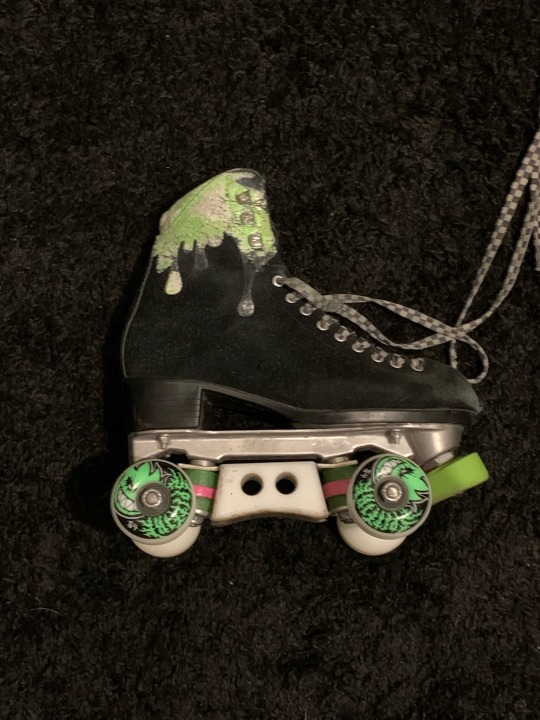


#aggressive roller skating#roller skating#skatelife#alternative#street style#street skating#slime skates#slime girl#spitfire#roller skates#roller skate#roller skate setup#custom roller skates#custom skates#skateboarding#diy skate#skate and create#skate or die#skate life#nonbinary#nonbinary skater#enbies
5 notes
·
View notes
Note
WOW you were the SK8R boy all along? No wonder you're so hot
I suppose this is as good if time as any to post this.
#Selfie#Selca#Sk8r boi#Aggressive inline#Skating#Video#Arnold impression#Sound fx#All my natural voice#Roller blading#Skate or die#Roller skates#Big air#Parkour#Guys who skate#I've cleaned this up but need to post again#Need someone to help me make a skate vid#Skate#Rollerblade#Inline skating#Avril reference#My video#Overcast#Suburbia
238 notes
·
View notes
Text
I’ve been thinking about the Straw Hats roller skating since I went recently, and the varying skill levels. Brook, Sanji, Nami, Robin, and Frankie?? They’d be tearing shit up. Zoro, however, if he could be convinced to skate, would be stiff as a board, moving mere inches at a time, falling again and again. And mostly because of Luffy, who is also falling and not any good, but like most cases, believes if he’s aggressive enough about it, he’ll succeed. So he’s just throwing his body around, trying to go as fast as he can, slamming into any of the other crew members he can. When not artfully skating and trying to avoid Sanji’s advances and pleas to skate with him, Nami is helping a tentative and very careful Usopp, who is actually getting the hang of it fairly quickly, save for when Luffy comes by to ruin it all. And Robin is either dutifully helping Chopper, endeared by his clumsiness and wobbling, or dancing all around the rink with Franky. Jimbei is watching from the sidelines, as this whole thing is pure entertainment.
#one piece#op#headcanons#sanji#zoro#nami#usopp#brook#nico robin#franky#jimbei#chopper#sanji vinsmoke#roronoa zoro#monkey d. luffy#roller skating#tony tony chopper
87 notes
·
View notes
Text
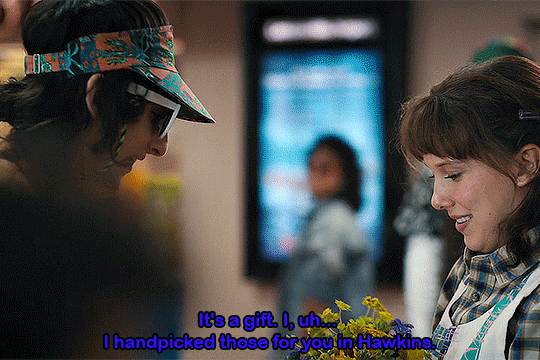
okay, i was just rewatching season 4, and i realized something, remember this scene in the airport right in the beginning of the series? Mike says “i handpicked those for you in Hawkins” most likely he got those from the field that we also saw in the end of this season, and the one of the very first scenes in season 3. now, i was watching the very last episode, and the very last scene, and i noticed when el was walking forward, she picked up dead flowers, specifically the same colors Mike got her as a gift back in the beginning (yellow and purple). this means the fall/deadness of their relationship, because as we already know, they are NOT on good terms. i mean i really tried to like their ship, but i just cant see it without being toxic, and having communication issues for example: El felt the need to lie about her life and Lenora, and how she had friends, and everything was good. why would she need to lie? shouldnt they trust each other and tell each other things like this? And back in the beginning when Mike tells Lucas that they dont want to be popular, and the airport scene when El says that she wants burritos for breakfast, Mike says something like “really? no i mean i trust you,” that scene to me meant that Mike was very awkward, and not acting like himself. and not to mention but Mikes outfit was not himself AT ALL. Argyle says “oh no its a shitty knockoff,” meaning again, that mike is acting like someone hes not in front of his girlfriend.
now, i wanna talk about the roller rink incident, because there is a LOT more stuff going on then what it seems. so basically Mike and Will are fighting while trying to find El, and Will says “well what about us?” and Will DID NOT mean this romantically, but Mike took this romantically?! Will meant it as “Ok i get it, you have a girlfriend, but what about our friendship?” Mike took it as romantic, which is why he said “We’re friend! We’re friends!” and the fact that he said it two times is also insane, and his tone of voice when he said it was so tense almost. when people in other shows/movies say they are just friends, they most if the time end up as an endgame couple. for example: the office, Jim and Pam, they both had crushes on each other throughout the first seasons, but oh look they were an endgame couple, and even got married. what im trying to say is, Mike took it romantically, when Will didnt.
And another thing with this fight, is that as soon as Mike said “We’re friends” the song “in the closet” started playing, and some people think “oh its because Els in a closet” which yes, in a way, but it was an employee’s shed. and also this song started playing RIGHT AFTER Mike assured that they were “just friends” little sketchy right? And i also just wanted to point out that after Mike said that, he saw Wills face and immediately knew he made him sad, and we can see the tension in his face almost disappeared.
now right after the skate incident, El, Mike and Will were all standing there in a triangle if i may point out, but anyways, we can see Will reacted normally, he said “oh my god..” but Mike reacted very aggressively towards it. and the camera pans over to El sitting alone at a table, and Mike and Will are right next to each other. really quickly, i wanna point a few things out. when angela takes el onto the rink, we can see Mike not care, hes just like “meh” but Will knows, so he stands up and says “oh no” which directly after he says that, he stands up so quickly, but this is weird for me. because Mike can sense when something is wrong with Will, but not El. because we see that when angela comes over to the table they are sitting at, it is very tense but Mike doesnt really notice, but Mike notices when something is wrong with Will almost IMMEDIATELY. and this is proven back in s2. so Will is closing his locker and Mike says something like “come on” and Will looks worried or even tense, and Mike immediately notices, because he says “what” many times and not to mention in his soft voice that he only uses for Will. so i think this means Mike understands Will and Will understands Mike.
i think this might be foreshadowing to the break up to Mike and El in season 5. so, once again. BYLER ENDGAME!!


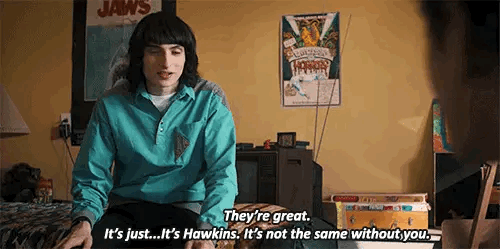
#byler#mike wheeler#mike wheeler is gay#will byers#byler endgame#byler is canon#byler kiss#byler nation#byler tumblr#stranger things#byler analysis#mileven break up#anti mileven
69 notes
·
View notes
Text
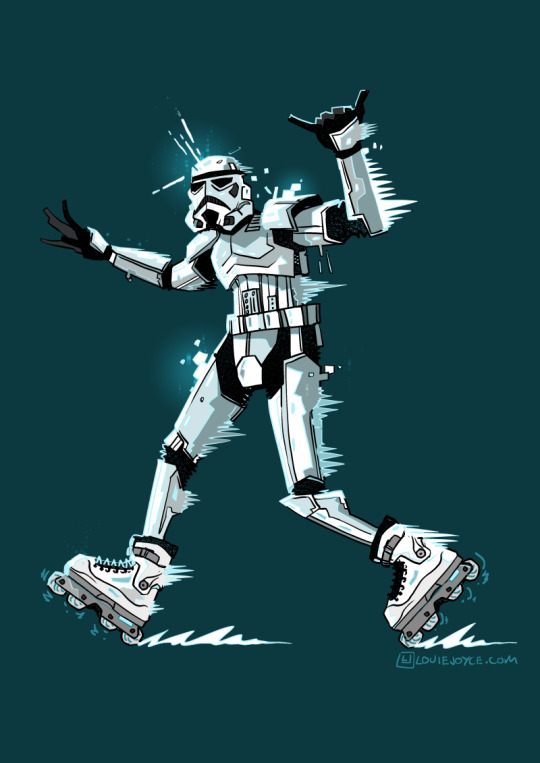

May the Froth Be With You!
www.louiejoyce.com
#louie joyce#illustration#comics#drawing#comic art#art#comic artist#comic books#star wars#stormtrooper#may the 4th be with you#rollerblading#inline skating#aggressive skating#froth#skate or die#roller skates#skate#character art#a new hope#shred#shaka#sketch
41 notes
·
View notes
Note
What I find interesting in all of the “Billy is worse than Henry Creel” discourse is that there is a widely-loved character who was groomed by Henry, abused by Brenner, isolated (albeit with good intentions) by Hopper, and shows more violent tendencies than Billy ever did: Eleven.
Eleven is a violent character who uses her power - power nobody else has - to exert her will. She forces a boy to piss himself in front of his classmates. She attacks Lucas for arguing with Mike. She attacks a man in the dead of winter, knocks him unconscious, and steals his clothing - possibly killing him if he doesn’t wake up before freezing to death. She tries to lash out at Angela with her powers, and later beats her face in with a roller skate. She even ripped Max’s skateboard from under her just for being near Mike. Hell, one of the very first things we see her do is break a doctor’s neck when they try to force her into solitary confinement.
All of these things are trauma responses. Bullying, raised voices, loss of control, desperation for survival - all of these things trigger aggression in Eleven just as Neil’s abuse and isolation trigger it in Billy. They’re both teenagers with a history of abuse and little to no support system. They’re both “bad” abuse survivors (except Billy didn’t even survive). So why are people so critical of Billy, but not Eleven? Is it her age, her gender, or the fact that her violence is mostly fantastical in nature?
Eleven is such an interesting character, but people are too busy infantilizing her to really think deeply about her trauma. She has a lot of empathy, but she’s also been groomed to use violence as a means to solve her problems. No one is teaching her how to cope with these new situations around her. Any time she does something wrong, she’s punished or she’s yelled at. She’s left feeling angry and ashamed and she’s got few healthy outlets for that. She has all of these complicated emotions inside of her, and that’s how she is able to relate to Billy. It’s also how she’s easily manipulated by others into doing what they want her to do - Papa, Henry, …even her own friends who she’s seeking approval, but it’s through her friends that she’s assigned as a “good survivor” who has “righteous” rage because the people she hurt “deserved” it, and it’s for that reason that so many people don’t want to have an open and honest discussion about what trauma can do to children, especially making them violent.
75 notes
·
View notes
Text
Monster Spotlight: Onyvolan

CR 3
Chaotic Neutral Monstrous Humanoid
Adventure Path: War for the Crown: Crownfall, pg. 86-87
Y’know, Pathfinder borrows creatures from just about every mythological, folkloric, and religious sphere on the planet, and every Bestiary contains a generous handful of creatures based on existing properties with enough differences that most people who recognize them will go “hey, I know that one!” Cute homages and references abound in Pathfinder, something I DO genuinely enjoy... But this one? I think the Venn Diagram crossover section between “people who play Pathfinder” and “people who’ve actually watched Return to Oz“ (or read the original sequel books) contains maybe 7 people. While not the most obscure property or story Pathfinder’s ever referenced, it’s definitely up there! I enjoy that Pathfinder’s version goes all the way back to the original story’s first description of them, making their wheels keratinous appendages instead of the mechanical augmentations they were in the movie.
And god does it make these things weird. In the whimsical Land of Oz, the weirdness of the Wheelers is perfectly at home and almost entirely glossed over as just another example of the strange natives of an even stranger world. In Pathfinder? ... well, they also don’t have an excuse. There’s ZERO explanation of where these creature’s come from, why they exist, and why they do what they do! Not even a handwave explanation of mad wizardry, magical contamination, a bloodline curse, or alchemical muckery. As far as anyone care to tell, they’re simply forms of bizarre wildlife that have evolved--naturally, magically, or otherwise--to live in human cities. And only in human cities, unfortunately; their wheeled appendages make them quick as a pony (40ft movement) and quiet as a whisper (+10 Stealth!) on flattened ground, beaten dirt roads, and stone pathways, but uneven surfaces prove to be a bane to them. They’re Easily Hampered, and any difficult terrain they encounter costs them 20ft of movement per 5ft square, slowing them to a glacial crawl.
Onyvolan are curious creatures through and through. They’re intelligent as any human and can hold perfectly lucid conversations in Common, but their entire being and culture seems to revolve around being roving gangs of bullies, scavengers, and thieves. They squat in unused buildings and abandoned homes, roving out to scavenge what they can from any source they can, prizing junkyards and garbage pits to vandalize nearby structures, as well as find food, trinkets for their odd collections, and especially clothing, their alien mindsets causing them to prize clothes above all other forms of treasure; the more garish, eye-searing, and ugly, the better. Gangs of Onyvolan look like groups of hideously-dressed street toughs on roller skates, and they act the part, too. They seem almost instinctually motivated to bully and scare any Humanoid they come across, as if they were perpetually in the mind-space of being belligerent and aggressive teenagers. often surrounding victims on all sides and shouting, growling, hissing, spitting insults, laughing, and whooping until they’ve had their fun with the object of their attention and rolling off. Their Creepy Cackle is noted to be particularly chilling, any creature within earshot needing to make a DC 14 Will save to avoid being shaken by the sound, and though success on the save renders the victim immune to that particular wheel-man’s Cackle for a day, the monstrous creatures are almost never alone.
If feeling especially brave (typically, this means outnumbering their target 3 to 1), Onyvolans will tackle and trip their victims, their Nimble Charger giving them +2 to Bull Rush and Overrun maneuvers (for a decent +9) and preventing victims from making Attacks of Opportunity in retribution. Once on the ground, Onyvolans will pilfer items from their unfortunate victim, grabbing articles of clothing or bags of groceries in their sharpened teeth before running off, cackling into the distance as they skate away at speeds the average human cannot match. Unlike a great many city-dwelling humanoids with sharpened teeth, Onyvolan aren’t man-eaters or even murderers, preferring to keep their crimes to muggings or breaking-and-entering. Their two slam attacks, each dealing 1d8+1 damage, are more for discouraging guards or punishing people who don’t fork over their belongings than actual tools for murder, and Onyvolans are Cowards (as every single bully is), easily shaken by any creature trying to Intimidate them back and preferring to flee from fights than stick around and see them to their end.
These creatures make for very strange encounters in metropolitan areas, wheeling in to harass and steal from the party before making a swift escape. Their relative harmlessness (in that they’ll beat you up but probably won’t kill you) and the low stakes they tend to involve themselves in (the most dramatic crime they’re stated to take is coordinated raids on clothiers and haberdashers) make them good targets for adventurers getting their own metaphorical wheels spinning, though despite their cowardice and the ruination that any amount of difficult terrain inflicts on them, one shouldn’t underestimate how punishing it can be to be shaken while surrounded by creatures that specialize in hitting people while they’re down. Just because you’re unlikely to die doesn’t mean you’re unlikely to lose and get all your clothes stolen, and few things are as damning to a beginning Wizard or Inquisitor as losing your big goofy hats. That’s practically like losing a class feature!
You can read more about them here.
87 notes
·
View notes